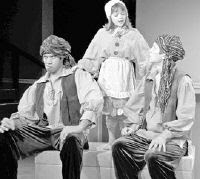Tom Swartwout film screening
Arts feature:
profiling film editor Tom Swartwout
The Ithaca Journal
November 15, 2007
683 words
"Ithaca's Tom Swartwout, editor of Sidney Lumet's films, to speak at Cinemapolis Friday"
full text here
Ithaca's Tom Swartwout, editor of Sidney Lumet's films, to speak at Cinemapolis Friday
By Mark Tedeschi
Special to the Journal
Revered writer/director Sidney Lumet has earned dozens of awards for his masterful work on more than 40 films over the past 50 years. He's fine-tuned the craft of garnering top-notch performances from some of the most respected actors of our time. His newest feature, “Before the Devil Knows You're Dead,” starring Philip Seymour Hoffman and Ethan Hawke, promises to be a riveting exploration of anxiety and family tension. But behind the scenes, Ithaca resident Tom Swartwout controls a vital part of Lumet's filmmaking process.
Swartwout has been the exclusive editor of Lumet's films since 1996. “I did television commercials in the early ‘90s,” he explains. Then, Swartwout had an opportunity to apprentice under Sam O'Steen, a Hollywood film editor who has worked for, among others, Roman Polanski and Mike Nichols. “[O'Steen] got a Sidney Lumet movie in 1995,” Swartwout continues. Something must have clicked: “After that, Sidney nicely offered me his next one and we've been working together ever since.”
Swartwout, an Ithaca resident since June, will attend the premiere for “Before the Devil Knows You're Dead” at Cinemapolis at 7 p.m. Friday, Nov. 16 for a question-and-answer period following the film.
Before moving to Ithaca, Swartwout resided in Brooklyn with his wife and two children; to that point, it was the longest he'd lived anywhere. “I moved around a lot as a kid,” he says. He graduated from Cornell in ‘86 with a degree in political science, but not before investigating another passion. “I had started developing an interest [in film] on my own,” he says. “Senior year, I took an intro to filmmaking class with [Senior Lecturer] Marilyn Rivchin. She gave me a lot of confidence... that was when I decided it was really what I wanted to pursue.”
Lumet's films are not the only projects that Swartwout tackles. Recently, he edited a television documentary about green technology written by New York Times op-ed columnist Thomas Friedman. Swartwout likes being able to take on work that he can complete from his home over a period of one or two months; that way, he's available if he gets another offer from Lumet. But, he adds, “For someone like Sidney, I'll go down to New York to work with him.”
The editing process contains myriad elements of preparation; editors must be familiar with a director's style and intention before delving into the heart of the work. Usually Lumet and Swartwout have just one meeting before shooting. “We've worked together a long time now,” he says, “so we understand each other and the shorthand we have. He'll talk about something that's worrying him or something he's excited for that he'd like me to think about as we're putting it together. Then, every day we'll screen footage and he'll talk about what he has in mind.”
Swartwout mentions that there are as many artistic choices as there are technical ones. “I like both,” he says, “especially nowadays when things are almost all done with some sort of digital work.” Lumet has shot all his work digitally, including this film, since 2000.
Shooting digital alleviates the tension of potential problems film can create. “Those issues don't come up at this level very often, but there's always that anxiety.” Swartwout says Lumet loves the look of the digital medium as well as the ability to instantly see what he's just shot.
“Sidney's budgets are always fairly tight,” he says. “He's very economic.” Part of Swartwout's job is to help determine, using their budget, what the crew can accomplish with lighting, color, and sound. “All of it is geared toward making [the process] better for Sidney,” he explains.
Between editing projects, Swartwout occasionally guest speaks at film classes at Cornell and Ithaca College. He says that he and his wife, a painter, moved back to Ithaca simply because they love the area. “We actually thought Brooklyn was great... we were just attracted to Ithaca.”
Swartwout looks forward to speaking this Friday. “I think it'll be fun,” he says. “Sidney did a remarkable job directing the actors... such strong performances. The film is dark, but it's not boring.”
Labels: feature, film, ithaca journal, profile



